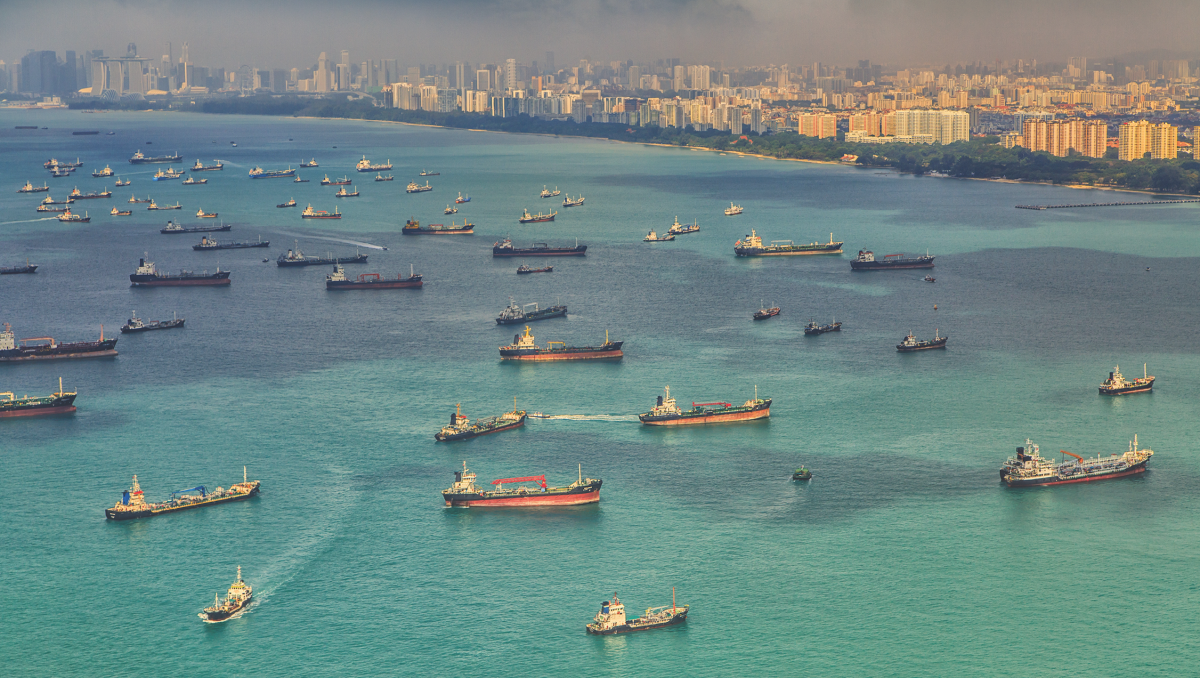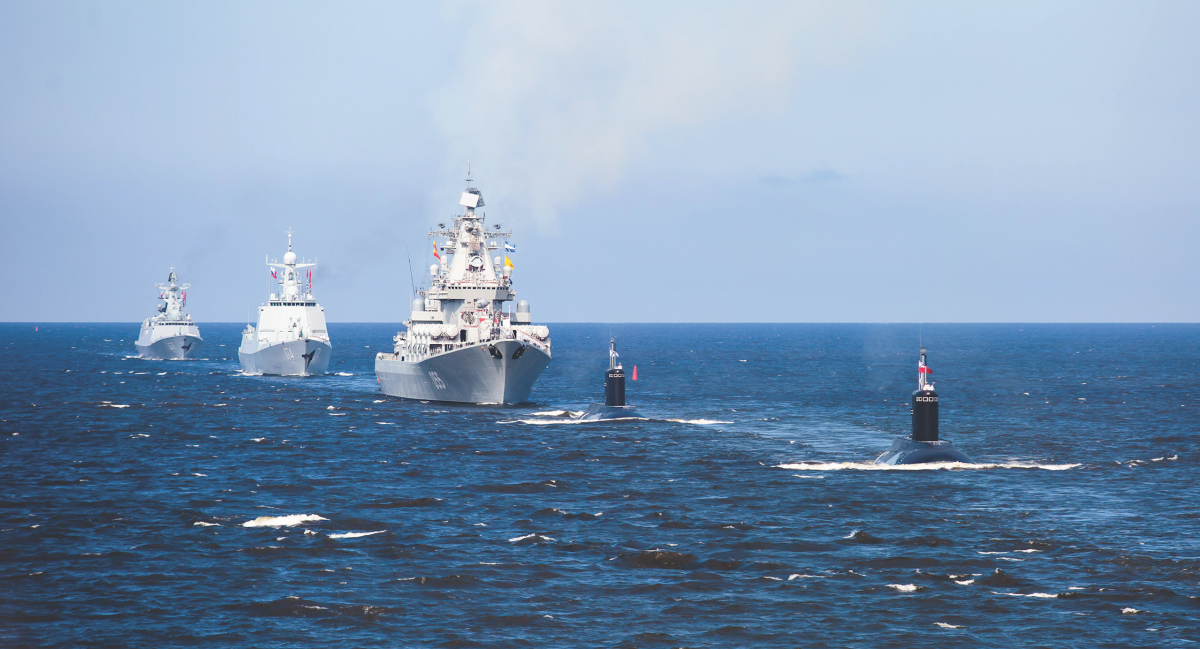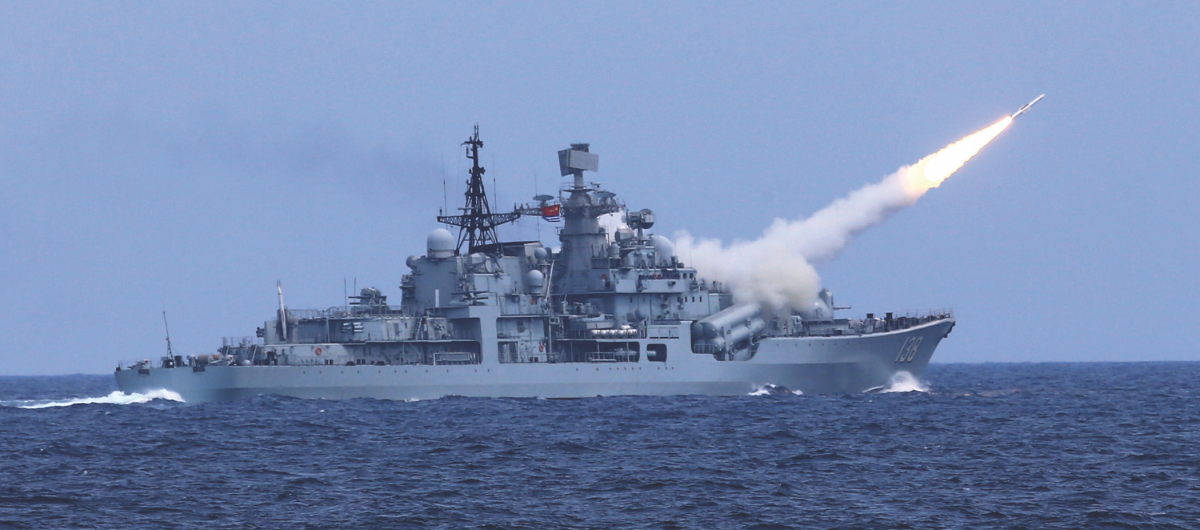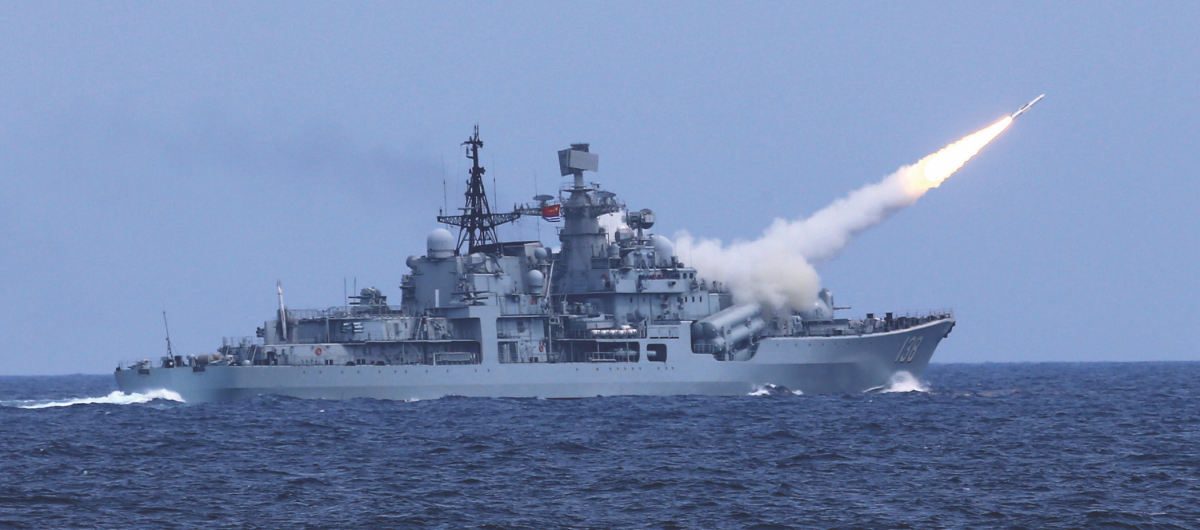The success of the naval intelligence community in providing situational awareness of what threats are over the horizon—or across the ocean—has been eroding steadily. If unchecked, this trend creates a fundamental deficiency in the fleet’s ability to conduct its core missions.
The root of the problem lies in three factors
Scope and Numbers
Fleet operations continue to grow in terms of scope and contacts of interest. Whether a resurgent Russia moving naval forces into the Mediterranean or a Chinese Navy growing in size and confidence, understanding what is taking place on the world’s oceans becomes more difficult each year. Unconventional threats shift the challenge from daunting to almost unfathomable. The Chinese People’s Armed Forces Maritime Militia, for example—a quasi-military force that has challenged U.S. units operating in the Western Pacific—has been estimated to comprise more than 140,000 vessels.1
Maritime Targets Are Going Dark
Emissions control (EmCon) has been part of naval warfare since the first radio direction-finding equipment was employed in the early 20th century. U.S. Navy exercises during the interwar years routinely featured fleet operations in extended EmCon.2 Increasingly more navies are rediscovering this fundamental technique, driven by the growing ubiquity of capable sensors. At the same time, U.S. Navy units are restricting their emissions in the face of capable adversary sensor networks.3
Long-Range Fires
With distributed lethality, the U.S. Navy’s surface force is returning to employing long-range fires against maritime targets—an operational skill not widely practiced since the Cold War. Similarly, carrier air wings are reemphasizing long-range maritime strike missions, which place a premium on over-the-horizon targeting skills in a maritime environment—skills that have not been a fleet focus in recent decades.
Aggravating these challenges is the impact of several decades during which maritime operational intelligence has not been the primary focus of naval intelligence. In an era of land-focused conflicts, where power was projected from secure sea bases and commanded and controlled through unchallenged supremacy in the electromagnetic spectrum, maritime operational intelligence took a secondary role to support to naval special warfare (NSW) and strike missions. The spotty accuracy and incompleteness of the maritime common operational picture (COP) and supporting common intelligence picture (CIP) presented to fleet commanders today are mute testimony of these factors. We can and should do better.
In answering this challenge, naval intelligence has two significant assets: the example of the Cold War–era ocean surveillance information system (OSIS) and the Navy’s current network of maritime operations centers (MOCs).

Past is Prologue
Mentioning OSIS in today’s information warfare community (IWC) is not politically correct. The accepted view is that the Navy has moved beyond this Cold War construct, and those who reference it are seen as not understanding the transformative effect of the IWC. Little institutional knowledge of the system has been passed on as the last officers and sailors with personal experience retire out of the force.
The reality is that OSIS—a worldwide network of fleet intelligence centers tied together by processes and systems—was a creative solution to a national-level intelligence challenge in the maritime realm. It was never static; it evolved throughout its two-decade-long history. At its best and most mature, it created cross-discipline approaches that represent the kind of synergy that the IWC is designed to produce.
The roots of OSIS extend as far back as World War II, but the formal creation of OSIS most clearly dates from 13 December 1968, when the newly renamed “Assistant for Ocean Surveillance and Intelligence Operations” under the Assistant Chief of Naval Operations for Intelligence (ACNO-I) was tasked to develop an all-source “Navy Ocean Surveillance Information Management System.”4 What came from this effort were “fleet-support operations within a node-driven decentralized approach.”5
The first physical OSIS facility opened in Rota, Spain, in 1970. This first fleet ocean surveillance information facility (FOSIF) was tasked to provide dedicated support to Sixth Fleet units facing the growing Soviet presence in the Mediterranean. It offered afloat forces “collection, processing, and dissemination with an eye to indications and warning intelligence; exploitation of Soviet command, control, and communications activity; more efficient surveillance and the appropriate sanitization of the resulting product for ?eet operators.”6 In the following two years, each major fleet established a fleet ocean surveillance information center (FOSIC), and each numbered fleet a nominally smaller FOSIF. Each of these “nodes” linked into a global data processing system centered at the Naval Ocean Surveillance Information Center (NOSIC) in Suitland, Maryland.7
While part of a world-wide system, the needs of the respective fleet commanders were central to the overall OSIS system and each individual OSIS node. Explaining the operational importance of the system to the director of the National Reconnaissance Office, the then-ACNO-I for intelligence wrote that “timely collection, processing and dissemination of ocean surveillance information provides the command with strategic warning through indications of changes in normal patterns of activity.”8 OSIS nodes reported directly to the fleet, with day-to-day operations conducted under the guidance of the fleet intelligence officer (N2). In many cases, the distinction between fleet staff and OSIS personnel was transparent. Both were part of the fleet, intimately tied to the commander and to fleet operations.
As the OSIS system grew and matured, it developed a series of characteristics that were instrumental in its success. Most of these never were articulated formally, but were “baked in” to the design of the system and the culture and relationships that sustained it.

National Priority
Parallel to the development of the OSIS system, during the late 1960s, Navy leaders worked to raise awareness within the Department of Defense and the intelligence community of the growing scope of Soviet naval operations. As a result of these missionary efforts, in 1970 the U.S. Intelligence Board formally declared “ocean surveillance as a national intelligence objective.”9 This designation opened the door for an unprecedented level of national-to-tactical intelligence integration, to include the first use of overhead satellite data in support of operations outside of intelligence community compartmented channels.10
Community Focus
For several generations, qualification as an OSIS watch officer was considered a key element of a naval intelligence officer’s professional development. This culture of rigorous analysis focused on a common adversary developed in-depth expertise across the community and created a commonality of experience that served to weld the community together.
Hand in hand with community focus came an investment in training, both formal and informal. By the 1980s, every watch officer received three weeks of formal instruction in the operations of the computer system that provided both analytic and reporting tools for OSIS.
While each OSIS node supported a distinct area of operations and command, the processes and procedures were largely uniform. Computer systems and the strictures of formal machine-to-machine and message traffic formats had the second-order effect of standardizing processes. Further, the movement of personnel between nodes during their careers ensured that best practices permeated across the enterprise.
In many ways, the development of OSIS was as much a response to increases in collection capability and in automated data processing as to the growing Soviet naval threat. The Office of Naval Intelligence had attempted to automate the compilation of merchant ship reporting as early as 1954. By late 1964, naval intelligence was studying the idea of a comprehensive ocean surveillance information processing system that could integrate information and sources across theaters.11
The first machine-to-machine transmission of electronic order-of-battle information occurred 25 July 1966 from the USS Independence (CVA-62) operating in the Mediterranean to the Atlantic Fleet headquarters in Norfolk. The key enabler of the OSIS system was the development of the integrated data processing system centered at NOSIC. Each step of this development involved cutting-edge work in automated data processing and a pioneering approach to the operational employment of “big data.”
Far from being single-discipline centers, the OSIS nodes relied on the integration of intelligence and cryptologic warfare. Embedded cryptologic warfare personnel, often organized into a cryptologic support group (CSG), were an integral part of the OSIS watch teams and command leadership. Indeed, the intimacy of the relationship caused alarm in its early days. Observing the close relationship between intelligence and cryptologic personnel at FOSIF Rota, one National Security Agency civilian wrote “there is no distinction between the FOSIF and the CSG … the CSG officer in charge knows the system and is only concerned with supporting the fleet in whatever manner he can … we have created an unchecked monster in Rota.” That determination to support the fleet was, of course, what the fleet valued, and can be seen as an early example of IWC integration breaking down information stovepipes. Just a few years after its establishment, the Sixth Fleet commander would cite FOSIF Rota’s groundbreaking signals intelligence-based reporting as the most valuable insight he received during the Soviet surge to the Mediterranean during the 1973 Arab-Israeli War.12
Fleet Intelligence Today
Today, command and control (C2) of the fleets—the Navy’s fundamental warfighting element—is exercised through the fleets’ maritime operations centers (MOCs), which represent an evolution of the staff structure that provided C2 for major naval campaigns throughout the 20th century. From their inception at Second Fleet in 2002, the MOCs have been focused on the operational level of war. By CNO instruction, Fleet Forces Command (FFC) is responsible for manning, training, and equipping all MOCs. To that end, FFC and the Naval War College provide a MOC training team that supports MOC training and exercises.13 Within each MOC, there is a maritime intelligence operations center (MIOC) through which C2 of intelligence is exercised. The MIOC is tasked with a range of functions, but its core elements—providing battlespace awareness, indications, and warning—closely parallel the requirements of the OSIS system.14
One asset that can be leveraged is the practice of intelligence federation. The most developed example at present is the Pacific Fleet Intelligence Federation (PFIF). Formalized by Pacific Fleet direction in 2013, the PFIF synchronizes the intelligence efforts of the three MIOCs within the Pacific (Pacific Fleet, Third Fleet, and Seventh Fleet), while folding in contributions from other Navy and joint partners. Interestingly, one of the reasons cited for its formalization in 2013 was a need for “reconstitution” of the capability to “find ships, submarines, and aircraft at sea.”15
Next Steps
The first and most critical step is for naval intelligence to respond to the fleet demand signal and embrace maritime operational intelligence as the community’s core competency. At present, maritime operational intelligence is just one of many critical tasks within naval intelligence. However, every other naval intelligence mission—support to special warfare, strike warfare, human intelligence, collection management, and more—is conducted by another element of DOD or the intelligence community. The element of sensing and understanding the operation of naval forces is unique to naval intelligence, however. It is naval intelligence’s task both by need and by exclusivity. The fleet cannot succeed without it, and no other entity can perform it for the operating forces.
With this essential first step in mind, there are steps naval intelligence can take to improve its abilities in the maritime realm.
Standardize
While MIOCs are “standardized,” there has been relatively little investment in creating future-focused standardization. Rather, the MOC standardization manual represents a lowest-common denominator of intelligence capabilities across the various fleets. Properly used, MOC standardization represents a driver for resources and manning, but would require concerted thought about what form a future MIOC should take.
Team with the Fleet for Systems Development
The OSIS experience underscores the importance of systems architecture in enabling fleet support. Today, our best systems are not standardized, while our standardized program-of-record systems are generally not good. Naval intelligence should take a page from the special warfare community and embed developers within the MIOCs, tailoring systems and interfaces to the operational intelligence problem.
Focus the Weapons Tactics Instructors
As the new Naval Information Warfighting Development Center grows into its mission, there is an opportunity to focus the intelligence and cryptologic warfare weapons tactics instructors (WTIs) on the challenges of maritime operational intelligence. WTIs should be the master instructors of both intelligence analysis and intelligence systems, carrying best practices from MIOC to MIOC.
Fold in the Afloat Nodes
The Cold War-era OSIS system envisioned folding together major afloat units. In reality, limitations of communications and afloat processing caused them at best to be advantaged users rather than participants. Current technology and systems, however, allow robust afloat participation, to include distributed intelligence production.
Report to Fleet Commanders
During the Cold War era, the decision to create OSIS nodes as independent commands was in part driven by sensitivity to staff size. In this current era of staff reduction efforts, that concern continues. However, establishing the MIOCs as commands would recognize their importance within the IWC. They would be distinctive from most IWC commands in that they would report to operational fleet commanders outside of the IWC, further validating the role of the IWC as a warfighting element.
OSIS for the 21st Century
Simply recreating the elements of the Cold War-era OSIS, however, would not address the new and dynamic challenges facing the fleet today. Rather, informed by past success, future MIOCs must evolve to meet new mission areas. At a minimum, future MIOCs need to comprise teams focused on three distinct elements.
Defense Watch
“Defense” represents the most traditional fleet operational intelligence mission—the surveillance of broad ocean areas with the goal of providing battlespace awareness in the maritime realm. Here, the key is the ability to detect and analyze patterns, providing indications and warning through the identification of changes in adversary operations. The defense watch bears a strong resemblance in process to the supplemental plot (SupPlot) that provides indications and warning as part of aircraft carrier intelligence centers (CVICs). At the operational level of war, however, the objective is to provide longer lead time to allow fleet-level maneuver. This requirement places a premium on analysis over collection and requires an acceptance of reduced tactical fidelity in future estimates.
Offense Watch
The “offense” team turns the traditional defense mission 180 degrees. While the tools used by the defense and offense watches are similar, experience shows that the two tasks require different mindsets and are best conducted by separate but closely linked teams. Rather than monitor an entire theater, the offensive watch focuses on a specific area of ocean in response to a short-term operational need. In some cases, it may be an area outside a strait or choke point where high-value adversary units are expected to transit. It also could be the area around the intended track of a surface action group (SAG) that would be within the range of its long-range antiship weapons. In any situation, the offense watch hunts, utilizing every sensor and system available to detect a narrow range of targets and pass the highest quality locational data available to tactical units.
Information Maneuver Support Watch
The newest and most challenging role for the future MIOCs is supporting maneuverability in the information realm. This task includes ties to cyber and network defense teams, as well as an ability to conduct adversary intelligence, surveillance, and reconnaissance (ISR) monitoring (AIM). AIM is a new concept, not yet articulated in doctrine. Simply, if the fleet is to evade adversary ISR, it must first understand it. That understanding must go beyond describing adversary ISR as a static system. ISR systems are dynamic. Potential adversaries shift their ISR in response to perceived needs and opportunities, and responses to them must be dynamic as well. While these responses may be conducted at the unit-level, the adversary ISR system must be understood as a complete system, making the MIOC the logical command echelon to address this challenge.
The Fleet is moving out
Given direction from the CNO to refocus on the high-end contested maritime fight, the fleet is moving out on new capabilities, concepts, and structures. In many cases, these new developments require profound levels of intelligence support. Fleet units, type commanders and developers are moving to meet these needs. These solutions, however, typically are “one-off” responses to a single task. There is a need for a comprehensive approach of the kind that only can come from an integrated intelligence system. The framework for such a system exists within the MOCs.
Naval intelligence has enjoyed its greatest success when it was integral to and enmeshed with the fleet. There is no better place to cement that linkage than within the fleet’s own C2 node. It is time to bring ocean surveillance into a new century.
1. Andrew S. Erickson and Conor M. Kennedy, “China’s Maritime Militia,” CNA Corporation, 7 March 2016, 2.
2. Albert A. Nofi, To Train The Fleet For War: The U.S. Navy Fleet Problems, 1923-1940 (Naval War College Historical Monograph Series). Newport, RI: Naval War College Press, 2010; Craig C. Felker, Testing American Sea Power: U.S. Navy Strategic Exercises, 1923–1940 (College Station, TX: Texas A&M University Press, 2013).
3. LTJG Zachary Holt, “Get Used to EMCON,” U.S. Naval Institute Proceedings, vol. 143, no. 7 (July 2017), 373; LTJG Daniel Stefanus, “Embracing the Dark Battle,” U.S. Naval Institute Proceedings, vol. 143, no. 4 (April 2017), 26–31.
4. Wyman H. Packard, A Century of U.S. Naval Intelligence (Washington, DC: Naval Historical Center, 1996), 342.
5. David A. Rosenberg, The Admirals’ Advantage (Annapolis, MD: Naval Institute Press 1998), 57.
6. Christopher A. Ford and David A. Rosenberg, “The Naval Intelligence Underpinnings of Reagan’s Maritime Strategy,” The Journal of Strategic Studies, vol. 28, no. 2 (April 2005), 379–409.
7. Packard, A Century of U.S. Naval Intelligence, 343.
8. VADM F. J. Harlfinger memorandum for the Director, National Reconnaissance Office (17 August 1970), quoted in “U.S. Navy/NRO Program C Electronic Intelligence Satellites (1958–1977),” originally classified SECRET//BYEMAN, National Reconnaissance Office, September 1998, declassified and approved for public release 13 June 2012, 193
9. “U.S. Navy/NRO Program C Electronic Intelligence Satellites (1958–1977),” iv.
10. Ibid., 191.
11. Packard, A Century of U.S. Naval Intelligence, 241, 245, 443.
12. Rosenberg, The Admirals’ Advantage, 57–59.
13. William Lawler and Jonathan Will, “Moving Forward: Evolution of the Maritime Operations Center,” Center for International Maritime Security, 19 October 2016.
14. Maritime Operations Center Standardization Manual, OPNAV M-3500.42, Washington, DC Office of the Chief of Naval Operations, 6 November 2014.
15. “Adm. Haney Signs Instruction for Pacific Fleet Intelligence Federation,” Ho’okele, 18 October 2013.




